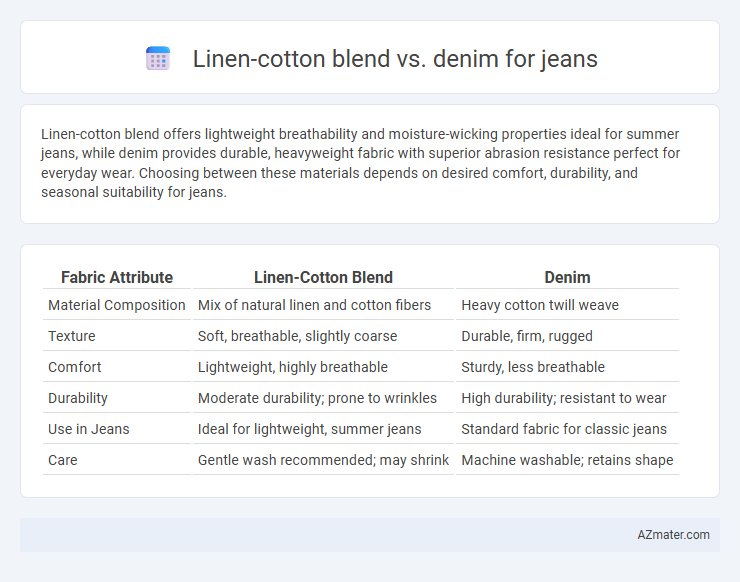Linen-cotton blend offers lightweight breathability and moisture-wicking properties ideal for summer jeans, while denim provides durable, heavyweight fabric with superior abrasion resistance perfect for everyday wear. Choosing between these materials depends on desired comfort, durability, and seasonal suitability for jeans.
Table of Comparison
| Fabric Attribute | Linen-Cotton Blend | Denim |
|---|---|---|
| Material Composition | Mix of natural linen and cotton fibers | Heavy cotton twill weave |
| Texture | Soft, breathable, slightly coarse | Durable, firm, rugged |
| Comfort | Lightweight, highly breathable | Sturdy, less breathable |
| Durability | Moderate durability; prone to wrinkles | High durability; resistant to wear |
| Use in Jeans | Ideal for lightweight, summer jeans | Standard fabric for classic jeans |
| Care | Gentle wash recommended; may shrink | Machine washable; retains shape |
Introduction to Linen-Cotton Blend and Denim for Jeans
Linen-cotton blend fabric combines the breathability and lightweight texture of linen with the softness and durability of cotton, making it ideal for comfortable, casual jeans suited to warm weather. Denim, traditionally woven from 100% cotton, is known for its robust, heavyweight texture and exceptional durability, commonly used in classic blue jeans that provide longevity and a structured fit. Choosing between linen-cotton blend and denim involves considering fabric weight, breathability, and the desired balance between comfort and ruggedness for jean construction.
Fabric Composition and Characteristics
Linen-cotton blend fabric combines the breathability and moisture-wicking properties of natural linen with the softness and durability of cotton, resulting in lightweight, highly breathable jeans ideal for warm weather. Denim, typically made from 100% cotton twill, features a sturdy weave that provides durability and resilience but is heavier and less breathable than linen-cotton blends. The linen-cotton blend offers a textured, casual look with quick drying capabilities, whereas denim provides classic ruggedness and structured fit, making each fabric suited to different styles and climates.
Comfort and Breathability
Linen-cotton blend jeans offer superior comfort and breathability compared to traditional denim due to the natural moisture-wicking properties of linen and the softness of cotton fibers. This blend allows for better air circulation, reducing heat retention and sweat accumulation, making it ideal for warm weather. In contrast, denim, typically made of heavier cotton twill, tends to be less breathable and can feel restrictive, especially in hot or humid conditions.
Durability and Longevity
Linen-cotton blend jeans offer a unique combination of breathability and softness but generally have lower durability compared to denim, as linen fibers wear out faster under frequent abrasion. Denim, especially made from tightly woven cotton twill, provides superior durability and longevity, resisting tears and fraying over years of wear. For long-lasting jeans that withstand heavy use, traditional denim remains the optimal choice, whereas linen-cotton blends suit casual, lightweight wear but may need more frequent replacement.
Style and Aesthetic Appeal
Linen-cotton blend jeans offer a lightweight, breathable texture with a natural matte finish, creating a relaxed yet refined aesthetic ideal for warm weather and casual elegance. Denim provides a sturdy, textured surface with deep indigo hues and classic fading patterns, emphasizing ruggedness and timeless style. The linen-cotton blend enhances softness and drape for a subtler silhouette, while denim delivers a more structured, iconic jean look.
Seasonal Suitability
Linen-cotton blend jeans offer superior breathability and moisture-wicking properties, making them ideal for warm weather and spring or summer wear. Denim jeans provide better insulation and durability, suitable for cooler seasons such as fall and winter. The linen-cotton combination excels in lightweight comfort, whereas denim ensures warmth and protection against wind and colder temperatures.
Care and Maintenance Requirements
Linen-cotton blend jeans require gentle washing with cold water and air drying to prevent fabric shrinkage and maintain softness, while denim demands durable washing cycles but also benefits from infrequent washes to preserve color and structure. Both fabrics benefit from avoiding bleach and minimizing exposure to direct sunlight during drying to enhance longevity. Proper maintenance of linen-cotton blends ensures breathability and texture retention, whereas denim care focuses on colorfastness and fabric strength.
Environmental Impact
Linen-cotton blend jeans significantly reduce environmental impact due to the sustainable cultivation of flax used for linen, which requires less water, fewer pesticides, and enhances soil health compared to cotton alone. Denim production traditionally relies heavily on cotton cultivation, contributing to high water consumption, pesticide use, and soil degradation, resulting in a larger carbon footprint. Choosing linen-cotton blend jeans supports lower resource use and promotes eco-friendly textile manufacturing practices in the denim industry.
Cost Comparison
Linen-cotton blend jeans typically cost more than denim jeans due to the premium nature of linen fibers combined with cotton, offering enhanced breathability and comfort. Denim, made primarily from cotton, is more widely produced and generally less expensive, benefiting from large-scale manufacturing efficiencies. The higher cost of linen-cotton blends reflects their durability and lightweight properties, making them a costlier but often more comfortable choice.
Choosing the Best Fabric for Your Jeans
Linen-cotton blend jeans offer superior breathability and lightweight comfort, making them ideal for warm weather and casual wear, while denim fabric provides durability, structure, and classic style suitable for heavy-duty use and all-season wear. When choosing the best fabric for your jeans, consider factors like climate, activity level, and desired fit, since linen-cotton blends tend to soften with wear and offer a relaxed aesthetic, whereas denim delivers robustness and a traditionally rugged appearance. For longevity and versatile style, denim remains a top choice, but linen-cotton blends excel in enhancing comfort and breathability during hot weather.

Infographic: Linen-cotton blend vs Denim for Jean
 azmater.com
azmater.com